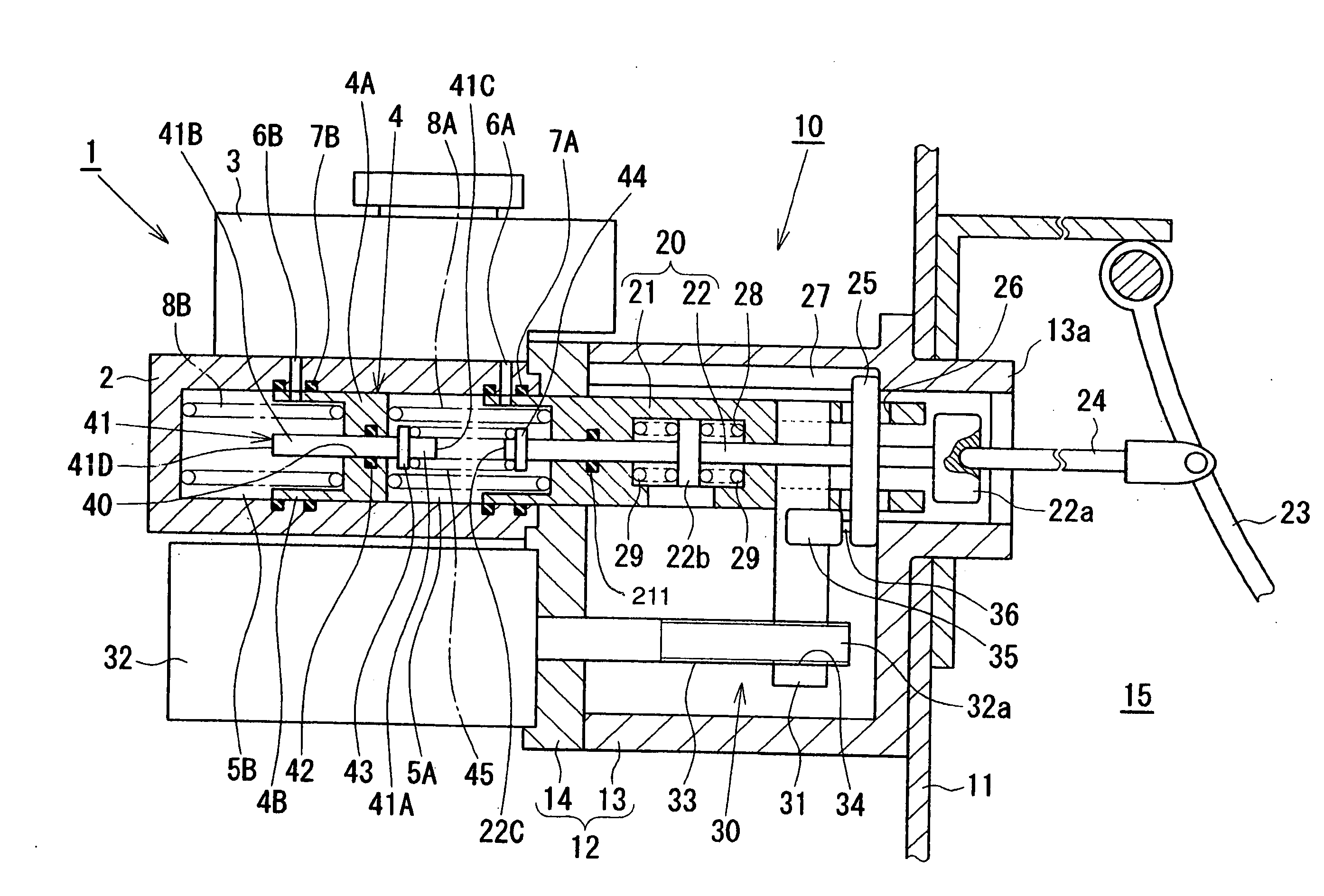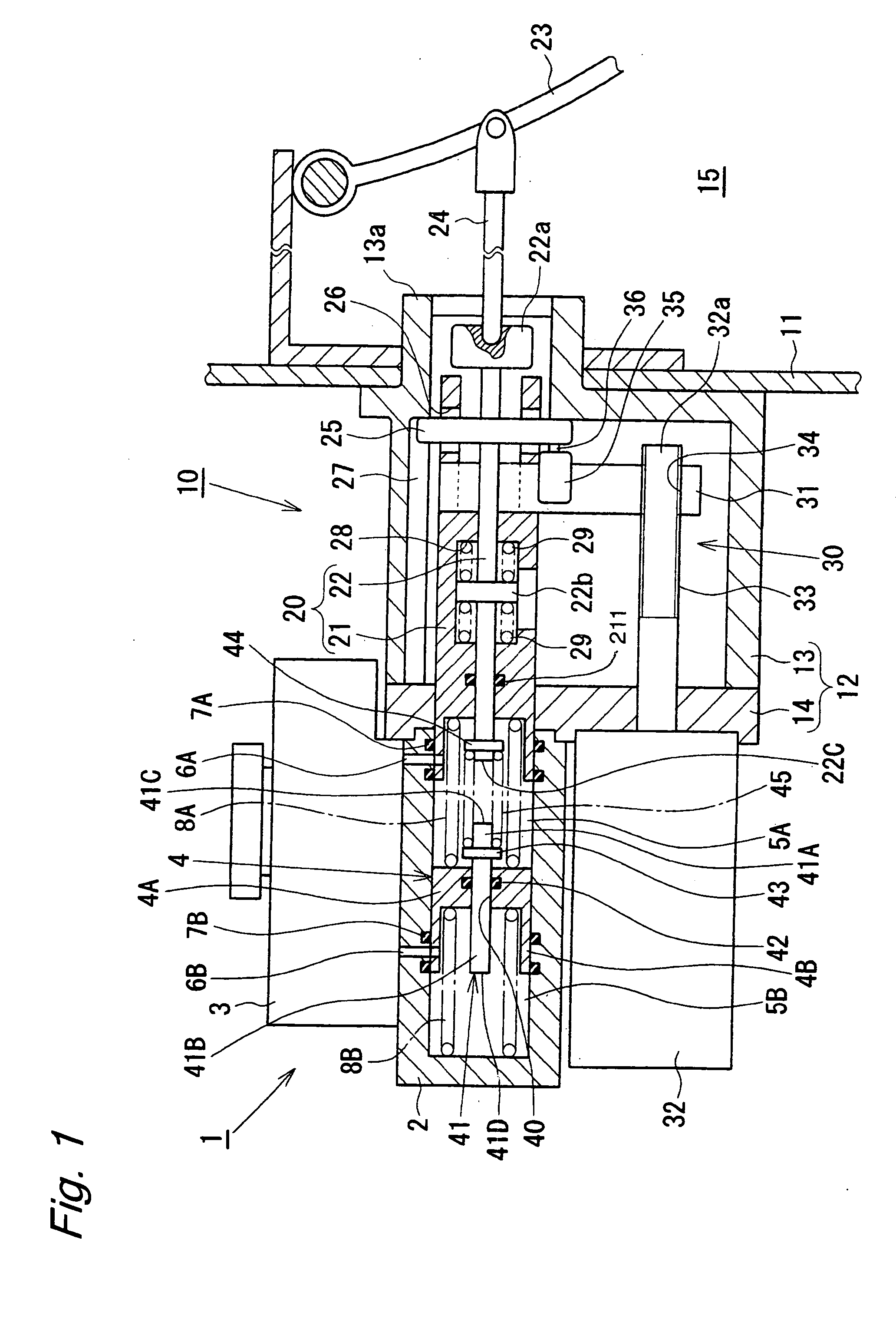Electrically driven brake booster and master cylinder
a brake booster and master cylinder technology, applied in the direction of braking systems, rotary clutches, fluid couplings, etc., can solve the problems of difficult increase, low fluid pressure in the primary pressure chamber, so as to achieve easy control
- Summary
- Abstract
- Description
- Claims
- Application Information
AI Technical Summary
Benefits of technology
Problems solved by technology
Method used
Image
Examples
first embodiment
[0012]FIG. 1 shows an electric booster according to the present invention. An electric booster 10 comprises a booster case 12 having one end fixed to a vehicle compartment wall 11 separating an engine room and a vehicle compartment, and the other end coupled to a tandem master cylinder 1 which will be described later. The booster case 12 comprises a bottomed case body 13 and a cover 14 covering an opening of the case body 13. While the case body 13 is fixed to the vehicle compartment front wall 11, the tandem master cylinder 1 is coupled to the cover 14 of the case body 13. Further, a cylindrical boss portion 13a is formed on a bottom plate portion of the case body 13, and the boss portion 13a extends into a vehicle compartment 15 through the vehicle compartment wall 11. The booster case 12 contains a piston assembly 20 and an electric actuator 30. The piston assembly 20 also serves as a primary piston of the tandem master cylinder 1, as will be described later. The electric actuato...
third embodiment
[0035]FIGS. 3 and 4 show the present invention. The third embodiment is characterized in that it employs, instead of the rod member 41 employed as an example of a transmission member in the first and second embodiments, an elastic member as another example of a transmission member. In the third embodiment, an electric booster 110 comprises a casing 111 having one end fixed to a partition wall W separating an engine room R1 and a vehicle compartment R2, and the other end coupled to a tandem master cylinder 101, which will be described later. Hereinafter, for convenience of description, the side of the engine room R1 is referred to as “front side”, and the side of the vehicle compartment R2 is referred to as “rear side”. The casing 111 comprises a cylindrical casing body 112, and a cover 113 attached to the rear side end of the casing body 112 by a bolt. A stepped wall 112a is integrally formed at the front end of the casing body 112, and the tandem master cylinder 101 is fixedly coup...
fourth embodiment
[0058]The characteristic features of the fourth embodiment will now be described in detail with reference to FIG. 5. As shown in FIG. 5, a circular groove 204a sharing a common radial center with a secondary piston 204 is formed on the base end side of the secondary piston 204, and a peripheral wall 204b is formed around the groove 204a. A step groove portion 204c is formed on the opening side of the peripheral wall 204b so as to have a larger diameter than that of the bottom of the groove 204a. In the groove 204a, a rubber reaction disk 161, which corresponds to an elastic member, is disposed so as to abut against the bottom of the groove 204a and the inner circumferential surface of the peripheral wall 204b. A ring-shaped push piece 262 is disposed in the groove 204a so as to abut against the opposite surface of the reaction disk 161 from the surface abutting against bottom of the groove 204a, and so as to be movable on the inner circumferential surface of the peripheral wall 104b...
PUM
 Login to View More
Login to View More Abstract
Description
Claims
Application Information
 Login to View More
Login to View More - R&D
- Intellectual Property
- Life Sciences
- Materials
- Tech Scout
- Unparalleled Data Quality
- Higher Quality Content
- 60% Fewer Hallucinations
Browse by: Latest US Patents, China's latest patents, Technical Efficacy Thesaurus, Application Domain, Technology Topic, Popular Technical Reports.
© 2025 PatSnap. All rights reserved.Legal|Privacy policy|Modern Slavery Act Transparency Statement|Sitemap|About US| Contact US: help@patsnap.com



